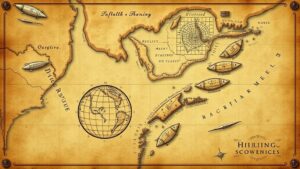Lost Cattle Drives: Using Trail Maps to Trace Forgotten Ranching Artifacts
Lost Cattle Drives: Using Trail Maps to Trace Forgotten Ranching Artifacts
Cattle drives were a significant and transformative aspect of American ranching culture, particularly from the mid-19th century to the early 20th century. These drives not only shaped the economy but also influenced the social and cultural landscape of the American West. But, many aspects of this rich heritage have become obscured over time. This article aims to delve into the importance of trail maps in tracing forgotten ranching artifacts and understanding the complex narratives of cattle drives across the United States.
The Historical Context of Cattle Drives
The cattle drive phenomenon began in earnest during the post-Civil War era, particularly in the 1860s. This period saw a surge in demand for beef in burgeoning urban centers in the East, which led to the establishment of cattle trails extending from Texas and other Western states. Notable trails included the Chisholm Trail, which ran from Texas through Oklahoma to Kansas, and the Goodnight-Loving Trail, which extended into Colorado and New Mexico.
According to the National Park Service, millions of cattle were driven along these trails, significantly impacting both the economy and the settlement patterns in the West. drives also cultivated a unique cowboy culture, marked by specific vernacular, clothing, and practices.
Significance of Trail Maps
Trail maps serve as invaluable resources for historians and archaeologists in locating and understanding the remnants of past cattle drives. These maps document not only the physical routes taken but also the locations of significant structures, watering holes, and other landmarks essential to the cattle-driving enterprise. The digitization of historical maps, such as those archived at the Library of Congress, has made it increasingly easier for researchers to cross-reference geographical data with existing archaeological findings.
- The Chisholm Trail–stretching approximately 1,000 miles–was instrumental in the development of several towns along its path, including Abilene, Kansas, which became known as the first cowtown.
- The Goodnight-Loving Trail facilitated cattle drives not just for beef supplies but also for introducing new cattle breeds to the markets in Colorado.
Methodologies for Tracing Artifacts
Utilizing trail maps involves a blend of historical research and fieldwork, often including the following steps:
- Map Analysis: Researchers begin by analyzing historical trail maps to identify key landmarks and routes.
- Field Surveys: Conducting on-site surveys enables the identification of remnants of historical ranch infrastructure, including stockyards, railheads, and homesteads.
- Geographic Information Systems (GIS): GIS technology can be employed to overlay historical maps onto current topographical maps, allowing researchers to visualize changes over time.
For example, a recent archaeological survey conducted along the Chisholm Trail identified remnants of a stockyard that had been critical to managing cattle during drives, providing essential insights into the operational dynamics of cattle ranching. Plus, data gathered from GIS applications revealed how environmental factors influenced the choice of routes.
Challenges and Limitations
Despite the usefulness of trail maps, researchers face numerous challenges in their efforts to trace forgotten ranching artifacts. Some of the main issues include:
- Erosion and Environmental Changes: Given the passage of time, natural erosion and land use changes can obscure or destroy artifacts.
- Reconciling Historical Narratives: Historical accounts can sometimes conflict, and differentiating between fact and folklore is complex.
Researchers often employ interdisciplinary methods to minimize these hurdles. For example, combining oral histories from local ranching communities with archaeological findings can paint a more accurate picture of past ranching practices.
Conclusion and Actionable Takeaways
The exploration of lost cattle drives and forgotten artifacts is essential for preserving American ranching history. Utilizing historical trail maps provides a framework for researchers to trace these artifacts, enabling a deeper understanding of their cultural significance. As the study of cattle drives continues, it is critical to
- Promote collaborative research initiatives across disciplines.
- Encourage the digitization of historical resources for broader accessibility.
- Engage local communities in preserving oral histories and site-specific knowledge.
Ultimately, the integration of trail maps and archaeological data enriches our understanding of the American Wests ranching heritage, ensuring that its stories–and the lessons they carry–are not lost to time.



